Basic rules and precautions:
For the use and drive of a hired 4×4 vehicle or any other vehicle, the basic rule is prudence. The handling of a 4×4 through the country can produce special situations: streams,slopes, hills and no ending circumstances that each one has to deal with and never put himself in danger, just how one would do with a conventional vehicle. Against and obstacle, it is always better desist than risk. For that reason, we insist in logic and prudence when it comes to driving. We stablished some basic rules for this kind of conduction:
Fastening the steering wheel:
When holding the steering wheel, fingers have to be out of it in case an obstacle makes the vehicle turn violently and harms our hands.
Obstacles:
In case an obstacle is found, it is always necessary to be sure that the vehicle can overcome it even if it is necessary to get out of the car to prove it. In case of doubt, it is better not to risk.
Blockage:
When a vehicle gets stuck, it is usually useless trying to come out of the situation. It is possible to get even more stuck. Sometimes it is as easier as slightly deflating the tyres or pull out a stone out of the way.
Transmission:
Reductive gears should not be engaged when the car is moving, it would cause a damage in the transmission. Each model has different ways to activate the 4×4 traction. In some cases, it is possible to do this on slow speed but, sometimes it is necessary come out of the vehicle to do this.
Windows:
It is advisable to close the windows. In this way, strokes and scratches will be avoided, as well as insects and dust coming inside the car.
Introduction
When driving a 4×4, there are some things to take care of. The big size, the tall heigh (that affects to its gravity center) and the weight of the car (that has an effect on breaking). The type of transmission with the use of gearboxes and differential options makes the use of this cars differ to others. Driving through the countryside implies knowing some specific techniques and understandings.
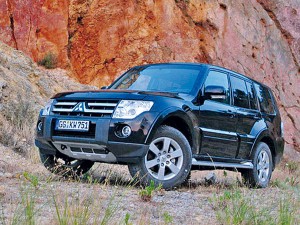
Gearbox use and operation 4×4 T.T.
2h: Two gears traction, generally the back ones, position for normal driving of the vehicle in roads in normal conditions.
4h: Four gears traction, the use of the clutch is needed to enter it and it can be entered in motion under 40 kms/h.
N: Neutral point. It is only used for the winch opertaion, ifn case the vehicle has it.
4l: Four gears traction plus gearbox. It is only used in difficult terrains with significative slope, where the 4h position does not work. Drive slowly and do not exceed 30kms/h. To enter and remove it, the vehicle has to be completely stopped and to unlock the wheels, reverse gear has to be activated, as in 4h position.
The operation to enter position 4l must be done with the vehicle and clutch stopped.
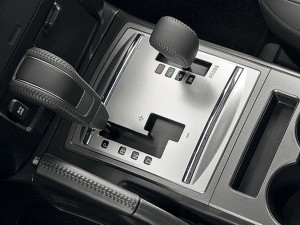
Tyre:
4×4 rented vehicles are provided with mixed tyres, due to their use in asphalt and field. Consequently, they must not be subjected to extreme agressions, avoiding pinches and cuts in the edges. At some point it is convenient to slightly deflate the tyres, inflating them with the recommended pression before starting to circulate normally.
Cleaning:
The vehicle has to be kept clean after its use and the radiator must be continously cleared of dried herbs and mud that can cause motor overheating from not receiving air from the radiator. The wheel arch and tyres must be cleaned with water to avoid vibrations when driving over asphalt and scratches inthe break disks. Breakdown in a remote place can be a big problem that we can avoid with simple cleaning tasks.
Clutch:
In 4×4 vehicles and in off road driving, clutch should be used as less as possible, avoiding skating. To go through a slope, it is also better to not use the clutch and let the vehicle’s motor stop and star it again. To get over an obstacle and go through something that stops the vehicle, you should follow the instructions given and not use the clutch too much.
Not being carefull with the use of the clutch can cause damages that paralize the vehicle, and this situations often happen in difficult to acces places, which causes a big problem.
Break-Motor:
It is important to use the retention motor power to break. Not using the break pedal is essential in some situations.
Embankment:
Step out of driving in embankments. If it is necessary, and always under the driver’s responsibility, it is better to drive as far from the border as possible. In that way, we’ll avoid the terrain falling because of the vehicle’s weight.
Seatbelt:
It should always be fasten. Traffic jams, a hidden road bump or a strong break can make someone precipitate onto the windscreen.
Features of 4×4 vehicles:
Max. Slope Possible:
The maximum inclination that the vehicle can ascend by its own strenght.
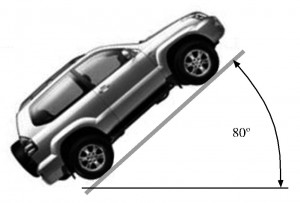
Maximum lateral inclination:
The maximum inclination the vehicle can have before turning over.
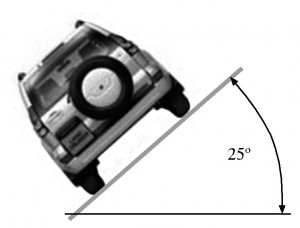
Angle of Attack:
The maximum angle the vehicle can make without scratching the lower part of the front bumper.
Exit angle:
The same as the Angle of attack, but in the back bumper.
Wade angle:
The maximum pick the vehicle can have between the axes before being touched in the lower part of the 4×4.
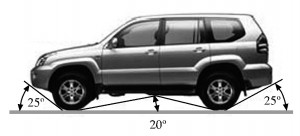
Wade capacity:
Maximum level water can reach in the vehicle without making it stop working.
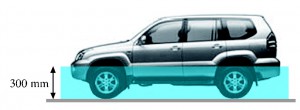
For the rented vehicles, the maximum angles can not reach more than 25 degrees, and the wade heigh is 30 cm. Every damage done by not respecting this rules, will be the renters responsibility.
Manual from 4×4 vehicle
It is convenient to talk about some basic rules for the rational and ecologic use of vehicles driving out of the road.
Since the ways have gotten more transited, there are new actuation rules that need to be respected to avoid this ways being umpassable at some point.
The recommendations given are:
Drive slowly and paying attention to possible obstacles and animal crossroads. For this reasons and for safety reasons, 4×4 vehicles should not circulate through non asphalted roads when there is a lack of solar light.
Enjoy the drive away from the pavement means appreciating the things the can be seen and taste the places that can be reached, but it is better to do it slow.
Is is important to avoid ridges and take away the obstacles from the way.
The vehicle should not overcome the marked route or root out bushes or branches. Cigarettes and waste should not be thrown away.
Rivers should not be used as sinks. Doors and fences should be correctly open and closed after each vehicle that passes through them. Animals have priority, the horn must not be pressed and the lights must be correctly used.
All of this terms have the purpose of protecting the enviroment.
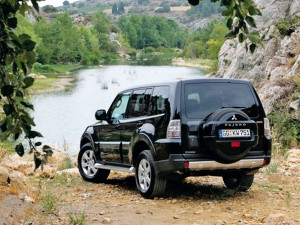
Driving over different floors:
Driving a 4×4 vehicle over asphalt is not much different form driving a normal vehicle. It is important to consider that 4×4 are higher and their gravity center is higher too. A 4×4 is heavier than an average vehicle, which is important to know when it is time for breaking. Even if the most modern models have advanced suspension and breaking systems, this information must be considered when driving a 4×4.
Mud
If the vehicle gets close to a mudded terrain, it is convenient to increase the speed, but always in short gears. It is not advisable to increase it violently, this would make the tyres skate, making the vehicle loose the direction control. It is better to mantain a constant speed.
If the speed is too slow, the vehicle can loose the impulse that makes it go over the obstacles, and it can even make the wheels turn over the mud and even sink in it. It is better not to go over other vehicles’ trails since it’s where the mud is more soft. If it is impossible avoiding them, the vehicle should go over the higher part of them.
If the steering wheel is moved slightly side to side, the wheels will stick better. Other times, it is better to let the vehicle find its own itinerary. The tyre’s pressure can get a bit lower so that there is more contact surface.
Snow
When there is not much snow, it is better to not turn or break very quick, this will make the car slide. In this cases, tyres break the upper layer of snow and stick to the ground.
When there is much snow, it is necessary to mantain an average level of turns in the motor, with a short gear and slow speed. This will make the tyre not slide over the snow. In case of extreme difficulty, chains are needed. On the road, the pressure will be the normal one, and on the country it is better to lower it slightly to increase the surface of the wheel.
Sand
When the sand is not compact, it is convenient to use 4×4 traction and a long gear with constant speed. If the vehicle sinks in the sand, use a short speed. In case of getting stuck, it is better to put something under the tyres to make them have traction to continue the way (stones, woods, etc..) and lower the pressure of the tyres.
Wading
Before driving through a wading zone it is convenient to go out of the vechicle and observe the characteristics of the terrain, checking this things:
If the flow is quick, the water will be transparent and there will be no slime on the bottom, so it is easier to see the way to follow. It is good knowing that when the water is transparent, it can look less deeper than how it is. If the depth is not clear, it is better to go through it walking to check it. A fast flow could drag the vehicle more than expected. If the flow is slow, there might be slime and mud on the bottom, and it will be important to check the depth as well, the obstacles and the bottom.

When wading, a short gear will be used (2nd), and the vehicle should be driven slowly and slightly inclined to avoid damaging the motor severely, and knowing that the water will slow the car, exerting force against it. It is important to choose the correct place to get out. When getting out, the break must be pressed to restore all its efficacy. Stop the vehicle and check if it has suffered damages (on the radiator, tyres, etc.). It is convenient to mantain the normal pressure of the tyres inside the water, since the obstacles will not ve visible under water.
Depending on the terrain type, there are different kinds of driving:
Slopes
Drive decisively.
Watch before initiating the ascension through the terrain, once started it is difficult to stop and change the way, or do sudden manoeuvres that will put the stability of the vehicle in danger.
If there is an obstacle, gears should not be changed or the vehicle will loose the rise impulse. Depending on the slope, it is convenient to use 2nd or 3rd gear.
In case of stopping during the ascension, break and clutchmust be pressed simultaneously, enter reverse gear and release the pedals so that the break motor makes it revert to the starting point. If the car stops, press the break, introduce reverse gear and let the car go back. The vehicle will start up on its own and the break motor will allow a slow descent.
Declines
Before starting declining, it is convenient to get out of the vehicle and observe the characteristics of the descent.
Do not use the clutch, the vehicle will break on its own in a short gear, helped by the breaking pedal.
If the vehicle slips, reduce the speed to make the tyres adjust to the terrain. Use the breaking pedal with extreme smoothness to avoid nailing the vehicle.
Avoid fast speeds during the descent and when getting to the end of the slope, care must be taken to not nail the front part of the vehicle on the floor.
Natural slopes and unevenness
If it is possible, avoid driving in slopes. Big stones can make the vehicle loose contact with the terrain, making it roll down slope. If it is impossible to avoid it, it is better to drive through it on the lower part, trying to mantain a relative balance.
If there is a danger of upturn, turn to the lower part and accelerate, this will make the vehicle have traction again.
Ditches and crests
It is convenient to confront them diagonally, entering with one wheel while the other three mantain the traction effort. It is important to make sure the direction is straight until the ditch is left behind.
The small and medium crests are confronted in the same manner to avoid ensnaring the vehicle, leaving it standing on its bottom and without the tyres touching the ground.
It is very important to respect the angles and measures given previously.
Rescue of the vehicle
Each time the vehicle gets stuck, a different situation appeares due to the different conditions in each case, and for that reason it is impossible to give strict indications for the rescue. In this section, general orientations are given that are applicable to the great majority of situations. Notwithstanding, prudence and ingenuity will be the most valuable weapons.
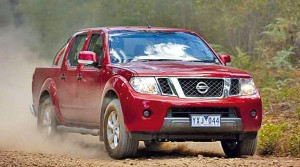
It is important to get away from the action rate from the wires and slings the vehicle is being dragged. If they broke, they could cause very harmful injuries due to the violence they fly out.
It is important to not work under a vehicle that is elevated with a hydraulic jack, since this tool or the terrain could move making the vehicle smash what is under it.
Every time the 4×4 vehicle is elevated, traction should be inserted in the four wheels and all the blocks. Furthermore, the first gear should be entered since thehand break often stops uniquely the back wheels.
It is better to retire all the obstacles and properly prepare the rescue to achieve it at the first try, rather than trying many times, which can make the situation worse.
When cables are used, gloves must be used to avoid the threads they usually have stick in our hands.
When a vehicle gets sunken in mud and another vehicle tries to get it out pulling it, traction causes a suction effect that entraps the sunken vehicle.
This could damage the structure of both vehicles if there is an insistence. If the sunken vehicle is elevated, this situation can be prevented.
Comeback to asphalt
When the countryside is left behind and the vehicle starts driving through asphalted roads, it is mandatory to turn the tyres pression to their normal state, the gearbox to the 2h position and make an exhausting cleaning (detailed previously). This reminder is for the safety of the driver and to avoid breakdowns caused by the bad use of the vehicle.
Very Important
The tenant driver of the car is responsible to make this actions and is the person assuming the risks of driving a 4×4. The compliance of the advices and basic rules (named previousy) of driving this vehicle out of asphalted roads, does not exempt the renter and driver from possible damages and breakdowns caused, being this person the one responsible for them and the person that will have to assume the costs to reestablish the vehicle to its original state.


